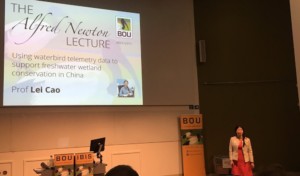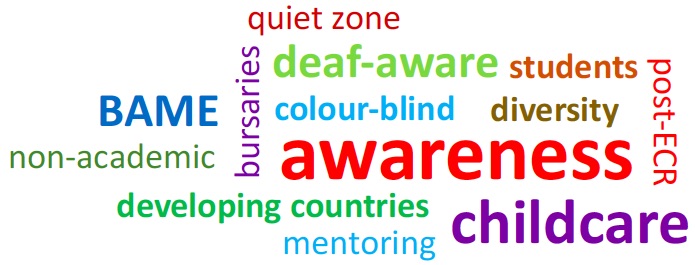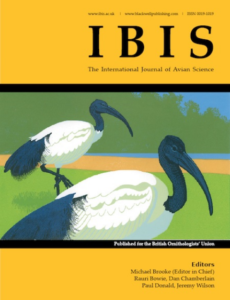Equality and Diversity (E&D) is more than just gender, race and ethnicity; it also includes people of different ages, sexuality, religions, physical and learning abilities and education levels. In the last few years, we have taken some important steps towards a more diverse and inclusive society that supports, embraces and showcases the diversity of our members and community from all backgrounds and career stages, and puts action behind the words of our E&D statement. Recognising the importance of this we have set up an E&D Working Group, appointed an E&D Support Officer and now have an elected Council member who will focus upon E&D issues.
Starting with gender, and with things that we can change, our current focus is on three areas of BOU activities: governance and structures, conferences and publications.
Governance and structures
We have set targets for 50:50 gender balance on Council and Committees by 2020. All key texts, such as adverts for BOU roles, awards, conferences and meetings are subject to a gender-decoder, to ensure they are not overtly gender-biased, and all staff, Council and committee members are now required to undertake annual unconscious bias awareness training.
In many cases, the key step to achieving gender balance is increasing the pool of female applicants or nominees for positions, roles or awards. While targets can be problematic, they can also provide a catalyst to think ‘outside the box’ and beyond immediate circles. To this end, our E&D Support Officer has been asked to develop approaches to ensure a 50:50 male:female short list for our awards. We have also taken an opportunity to name the newly-designed BOU Union Medal after Janet Kear; overdue recognition of a visionary former BOU President and IBIS Editor.
Conferences
Underrepresentation of women and minority groups as conference speakers, plenaries and session chairs is in part a symptom of the lack of equality and diversity within ornithology in the UK. Left unchecked it can serve to perpetuate and reinforce these inequalities.
Research suggests that among the top barriers limiting women’s participation as speakers is the tendency for conference organisers to select the ‘usual suspects’ and devote little effort to finding other qualified individuals, particularly women, for these roles (1). The imbalance is exacerbated by a tendency for women to be less likely to promote themselves.
The BOU has committed to equal representation of men and women as keynote speakers and session chairs at all our meetings and conferences – and to putting in the effort to try to find them!

Prof Lei Cao delivering the BOU’s 2019 Alfred Newton Lecture at BOU2019.
Submitted abstracts are less under our control, but we already use blind reviewing of abstracts for presentations, to help overcome some of the unconscious biases we all have. We will continue to review progress towards a 50:50 gender balance in accepted talks and posters and, wherever possible, we will ensure there are no ‘all men’ or ‘all women’ sessions in any meeting programme – and certainly no all-male panels.
Question-time after talks can help create an inclusive environment, where everyone feels encouraged to participate. We will be recommending that chairs try to start questions with a woman, early career researcher or a member of a minority group.

Simple initiatives, such as seeking suggestions from conference delegates on equality, diversity and inclusiveness issues, are yielding some fantastic feedback and raising new issues for us to tackle which will benefit our community.
At #BOU2019 we asked for your views on how we can do better on equality, diversity and inclusivity. Delegates gave us some great ideas, many of which we should have thought of already, but hadn’t – sorry!
- You asked us to be more aware of those with visual impairment and hearing difficulties and we will revise our conference guidelines for speakers and session chairs accordingly.
- To ensure presentations are accessible to all we will, for example, ask speakers to ensure that they are in a font and colour that those with dyslexia or other reading difficulties are better able to read, and to be colour-blind aware when selecting colour schemes of fonts/figures and backgrounds.
- We will also impress on session chairs and speakers that microphones are compulsory, even for a speaker with a loud voice!
- There was also a suggestion of the need for a quiet space. Whilst we know many attendees value the networking opportunities conferences provide, sometimes all this ‘mixing and socialising’ can be overwhelming. A quiet space would provide somewhere for people to take a break from interacting and we will endeavour to provide such a space at #BOU2020.
- The BOU is proud of its dynamic ECR community and will continue to support it, but we also want to make post-ECR life at the BOU better. To this end #BOU2020 will also have a social for post-ECR delegates – a chance to get to know others at this stage and, we hope, come up with some suggestions as to what BOU can do for you and vice versa.
 Word cloud based on suggestions collected at the BOU2019 annual conference
Word cloud based on suggestions collected at the BOU2019 annual conference
Other suggestions from #BOU2019, such as childcare provision and attendance bursaries for some groups, will take a bit more thought (and money) and our E&D Support Officer has been charged with looking at issues such as these. We will take our E&D suggestion box at all our events, so please keep ideas coming.
 Publications
Publications
Finally, growing quantitative research shows women are generally underrepresented as authors compared to men (2), particularly with respect to first- and last-authors (3,4). Numerous explanations have been proposed as to why, with the role of unconscious bias frequently cited. This has led several journals to move to double-blind reviewing and we are delighted that BOU’s flagship journal, IBIS, has recently done the same.
Double-blind review has its limitations of course – it is still sometimes possible to know who the authors are and some feel knowing the identity of the author allows for a more informed decision. However, the IBIS Management Committee felt these limitations are outweighed by the advantage of allowing the research to be judged more fairly. As with any major change, we will monitor the switch to double-blind carefully, in discussion with authors, reviewers and our Associate Editors. We will also evaluate how this impacts on equality and diversity of authors publishing in IBIS.
Summing up
Equality & Diversity is about everybody. We want to receive the best papers for IBIS, hear the best speakers at our conferences and have the best people in the room for our committee meetings. The policies that we are pursuing are about engaging with as many people as possible, for the benefit of the Union and the ornithological community that we support.
References
- Chautard, A. & Hann, C. 2019. Best practice guide: developing inclusive conferences. School of Geography and the Environment report, University of Oxford. VIEW
- Bendels, M.H.K., Muèller, R., Brueggmann, D., Groneberg, D.A. 2018. Gender disparities in high-quality research revealed by Nature Index journals.PLoS ONE 13(1): e0189136. VIEW
- Edwards, H.A., Schroeder, J., Dugdale, H.L. 2018. Gender differences in authorships are not associated with publication bias in an evolutionary journal. PLoS ONE 13(8): e0201725. VIEW
- Fox, C.W., Ritchey, J.P., Paine, C.E. 2018. Patterns of authorship in ecology and evolution: First, last, and corresponding authorship vary with gender and geography. Ecology and Evolution. 2018. 8: 11492–1. VIEW
Image credits
Featured image: People rawpixel.com CC0 pxhere.com
Bottom right: Based on OpenClipart-Vectors CC0 pixabay.com




